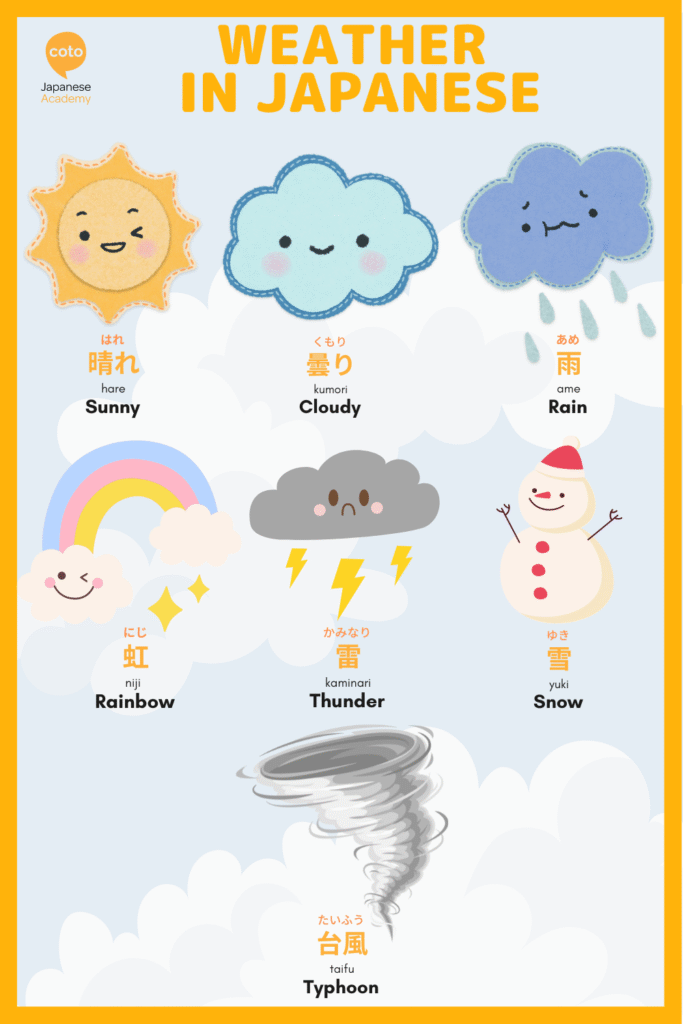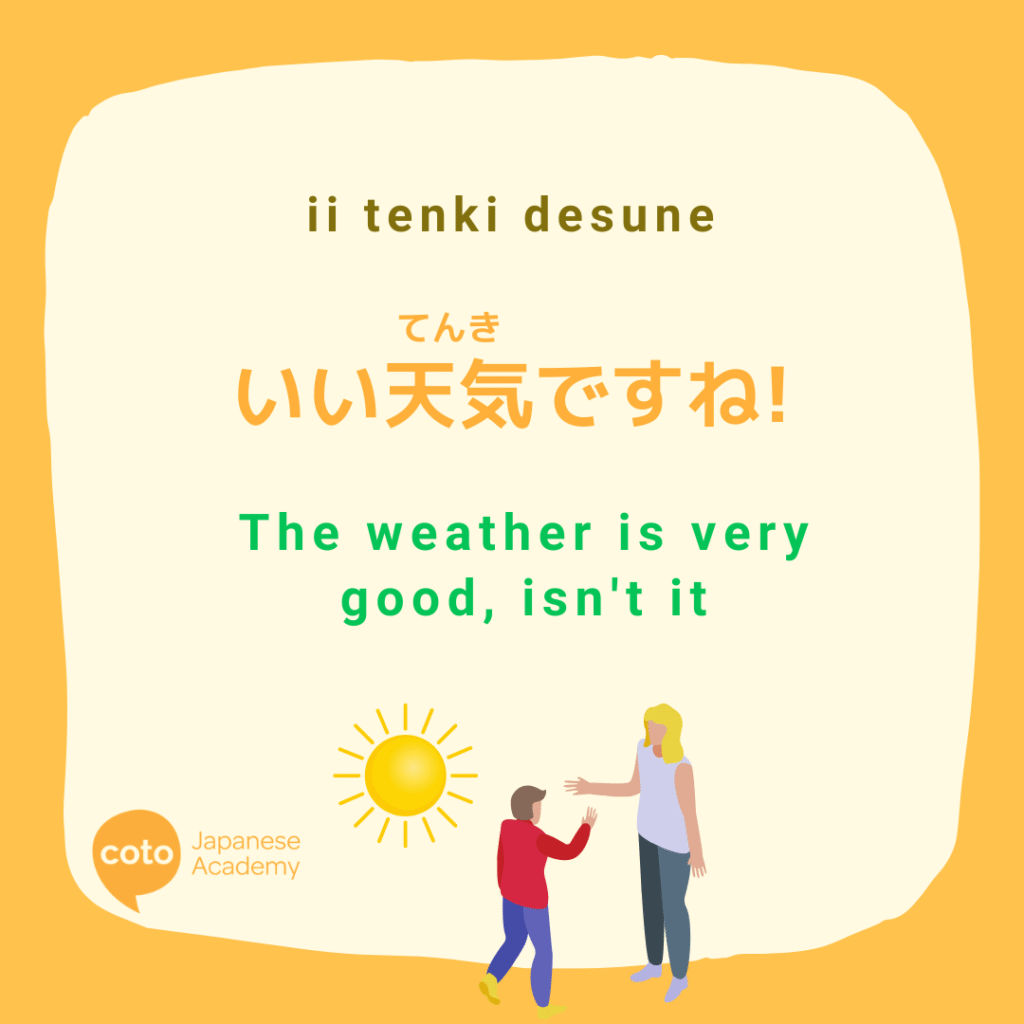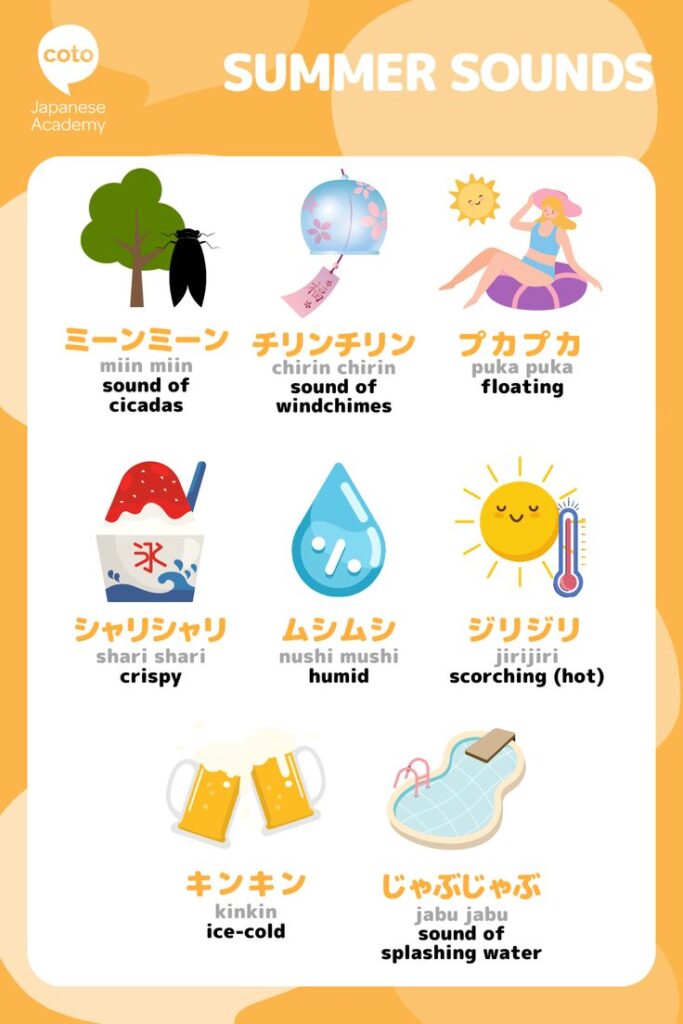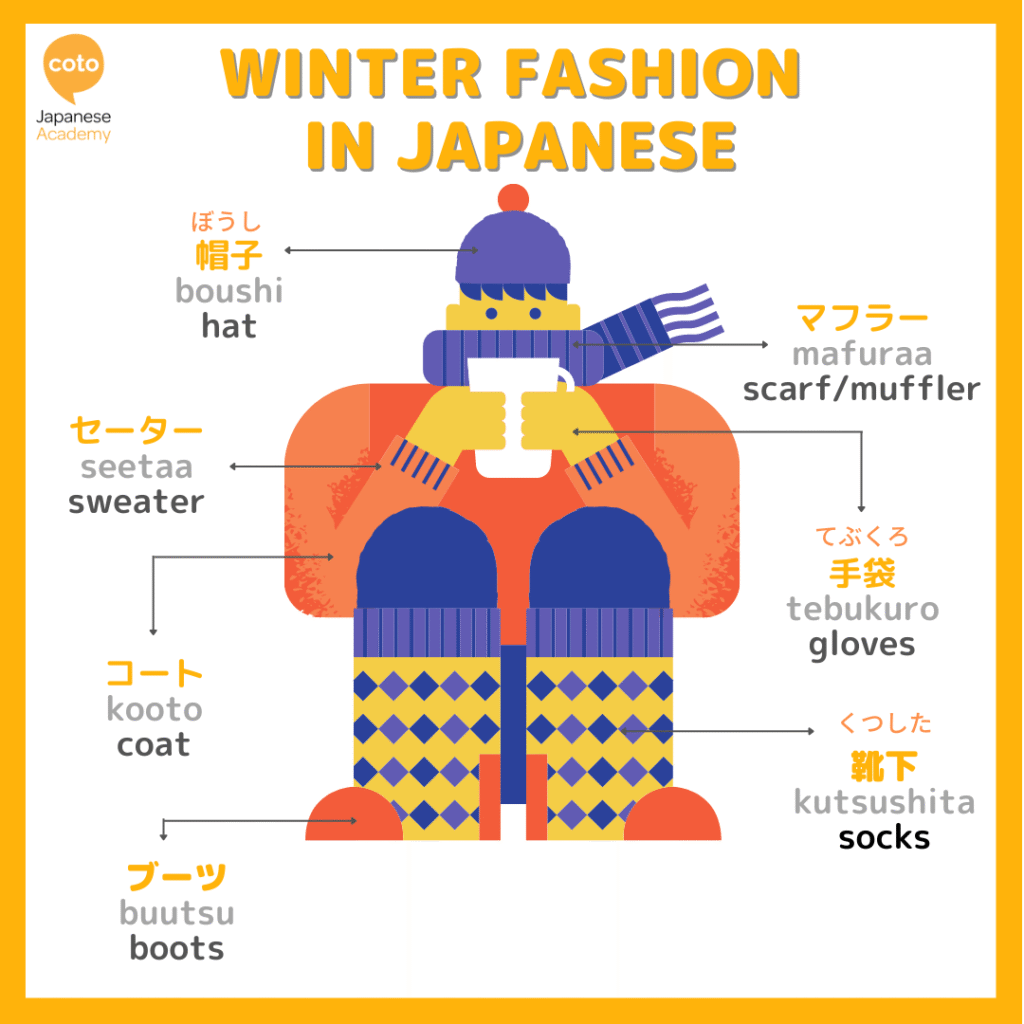Besides its high-tech cities, rich traditions, and delicious food, Japan’s four seasons are equally unmatched and deserve as much attention as matcha and sakura blossoms. There’s the crisp, colorful air of autumn during momiji (autumn leaves) season, the hot and humid summer days perfect for the beach, and everything in between. What better way to show your appreciation for them than by talking about the weather in Japanese?
Just like anywhere else, weather talk is a classic icebreaker. It’s simple, useful, and part of everyday conversation. But how do you describe a sweltering summer, a dry winter, or the brief, magical bloom of the sakura?
In this guide, we’ll go through all the different ways to talk about the weather in Japanese, from daily temperatures to seasonal fluctuations.
Let’s start with the basics: common Japanese words for talking about the weather. Just like in English, in Japan we describe the weather using elements like temperature, the sky, clouds, sun, rain, and more. Here are some essential words to get you started.
Basic weather elements

| English | Furigana | Kanji | Romaji |
| Weather | てんき | 天気 | tenki |
| Sun | たいよう | 太陽 | taiyou |
| Cloud | くも | 雲 | kumo |
| Rain | あめ | 雨 | ame |
| Snow | ゆき | 雪 | yuki |
| Fog | きり | 霧 | kiri |
| Thunderstorm | かみなり | 雷 | kaminari |
| Snowstorm | ふぶき | 吹雪 | fubuki |
| Wind | かぜ | 風 | kaze |
Once you go beyond the basics, Japanese has a rich vocabulary of seasonal and poetic weather words. Many of these are hard (or impossible) to translate directly into English, because they carry nuance and seasonal imagery.
Here’s a list of more advanced and “untranslatable” Japanese weather-related words:
| English | Kanji | Hiragana | Romaji |
|---|---|---|---|
| Sunshine | 日照 | にっしょう | nisshou |
| Drought | 日照り | ひでり | hideri |
| Clear skies | 晴天 | せいてん | seiten |
| Sunbeam / sunlight | 光跡 | こうせき | kouseki |
| Moon | 月 | つき | tsuki |
| Moonlight | 月明かり | つきあかり | tsukiakari |
| Autumn shower rain | 時雨 | しぐれ | shigure |
| Early summer rain | 五月雨 | さみだれ | samidare |
| Fresh greenery (spring) | 新緑 | しんりょく | shinryoku |
| Spring breeze | 春風 | はるかぜ | harukaze |
| Autumn breeze | 秋風 | あきかぜ | akikaze |
Basic weather conditions
So far, we’ve listed basic nouns, but how do you describe the intensity or manner of the weather, like heavy rain, strong wind, or pouring snow? The adjectives below are used to describe these conditions.
| English | Furigana | Kanji | Romaji |
| Sunny | はれ | 晴れ | hare |
| Cloudy | くもり | 曇り | kumori |
| Hot | あつい | 暑い | atsui |
| Cold | さむい | 寒い | samui |
| Humid | じめじめ | — | jimejime |
| Hot and humid | むしあつい | 蒸し暑い | mushiatsui |
| Dry | からから | — | karakara |
| Windy | かぜがつよい | 風が強い | kaze ga tsuyoi |
| Chilly | すずしい | 涼しい | suzushii |
| Freezing | こおりつく | 凍り付く | kooritsuku |
| Stormy | あらしの | 嵐の | arashi no |
| Foggy | きりのかかる | 霧のかかる | kiri no kakaru |
| Snowy | ゆきふる | 雪降る | yuki furu |
| Overcast | どんよりしている | — | don yori shite iru |
| Mild | ほどよい | — | hodoyoi |
| Freezing cold (very) | さむさきびしい | 寒さ厳しい | samusa kibishii |
In Japanese, to describe the intensity or nature of the weather, you usually combine an adjective with a weather noun. The adjective describes how the weather feels, while the noun tells you what kind of weather it is.
Examples:
強い風
Tsuyoi kaze
Strong wind
大雨
Ooame
Heavy rain
Some adjectives are standalone (like 大雨 or 吹雪) and act as nouns themselves, while others use い-adjectives or な-adjectives directly before the noun:
暑い日
Atsui hi
Hot day
湿った空気
Shimetta kuuki
Humid air
Now that we’ve covered some common weather vocabulary and how to pair adjectives with nouns, let’s move on to temperature and seasons! If you want a deeper dive, we have a dedicated blog about describing Japan’s seasons. Be sure to check that out for more details.
| English | Furigana | Kanji | Romaji |
| Temperature | きおん | 気温 | Kion |
| Temperature | おんど | 温度 | Ondo |
| Humidity | しつど | 湿度 | Shitsudo |
| Four seasons | しき | 四季 | Shiki |
| Rainy season | つゆ | 梅雨 | Tsuyu |
| Dry season | かんき | 乾季 | Kanki |
| Spring | はる | 春 | haru |
| Summer | なつ | 夏 | natsu |
| Autumn | あき | 秋 | aki |
| Winter | ふゆ | 冬 | fuyu |
| Early Spring | はるはじめ | 春始め | haru hajime |
| Late Summer | なつおわり | 夏終わり | natsu owari |
| Late Autumn | あきおわり | 秋終わり | aki owari |
| Early Winter | ふゆはじめ | 冬始め | fuyu hajime |
Although Japan is officially a four-season country (shiki), you might notice that we’ve included two additional “seasons”: tsuyu (the rainy season) and kanki (the dry season).
Tsuyu usually occurs from early June to mid-July, bringing frequent rain and high humidity to most of the country (except Hokkaido). On the other hand, kanki, or the dry season, refers to periods with clear, crisp air, often in winter or early spring, when the skies are bright and the humidity is low. While these aren’t official seasons like spring or autumn, the weather patterns create the feeling of “extra” seasons.
Note: If you notice that there were two words for temperature in Japanese, 気温 (kion) and 温度 (ondo), it is not a coincidence. Kion is used to describe only the temperature of the air, while anything, including water temperature or the temperature of something you touch, can be ondo.
Key phrases used to describe the weather in general

Now that you’ve got the basics and all the essential weather vocabulary down, it’s time to put them to use! Let’s go through common phrases and questions you’ll hear, or want to ask, when talking about the weather in Japan.
Weather-related questions
Let’s start with the questions first! They are often a great way to get to know someone or open up to a conversation.
今日の天気はどうですか。
Kyou no tenki wa dou desu ka.
How’s the weather today?
気温は何度ですか。
Kion wa nan-do desu ka.
What is the temperature?
明日は雨が降りますか?
Ashita wa ame ga furimasu ka?
Will it rain tomorrow?
暑い天気は好きですか?
Atsui tenki wa suki desu ka?
Do you like hot weather?
外は風が強いですか?
Soto wa kaze ga tsuyoi desu ka?
Is it windy outside?
ここはよく雪が降りますか?
Koko wa yoku yuki ga furimasu ka?
Does it snow often?
Weather-related small talk and answers
Now, let’s also make matching answers using the same structure, so you can answer naturally in conversations.
はい、ここはよくあめがふります。
Hai, koko wa yoku ame ga furimasu.
Yes, it rains here often.
いいえ、東京では雪はあまり降りません。
Iie, Toukyoudewa yuki wa amari furimasen.
No, it doesn’t snow much in Tokyo.
はい、この地域では風がよく強く吹きます。
Hai, kono chiiki dewa kaze ga yoku tsuyoku fukimasu.
Yes, it often gets very windy in this area.
はい、北海道では冬に雪がたくさん降ります。
Hai, Hokkaidou dewa fuyu ni yuki ga takusan furimasu.
Yes, it snows a lot in Hokkaido in winter.
いいえ、この町では夏に雨はあまり降りません。
Iie, kono machi dewa natsu ni ame wa amari furimasen.
No, it doesn’t rain much here in summer.
Talking about hot weather in Japanese

We’ve already covered the general phrases and common patterns for talking about the weather in Japan, but now let’s look at some examples for when the season is dry or hot. One thing to note: in Japan, there’s a unique word called mushiatsui. This word combines “hot” and “humid” and is used to describe that heavy, sticky feeling typical of Japanese summers. It’s a word you’ll hear often during the hotter months, especially when the air feels thick and muggy.
Let’s out some vocabuulary first before moving on to phrases!
| English Meaning | Kanji | Hiragana | Romaji |
|---|---|---|---|
| Summer day (over 25°C) | 夏日 | なつび | natsubi |
| Midsummer day (over 30°C) | 真夏日 | まなつび | manatsubi |
| Extremely hot day (over 35°C) | 猛暑日 | もうしょび | mōshobi |
| Heat / hot weather | 暑さ | あつさ | atsusa |
| Extreme heat | 猛暑 | もうしょ | mousho |
| Heat wave | 熱波 | ねっぱ | neppa |
| Humidity | 湿気 | しっけ | shikke |
| Hot and humid / muggy | 蒸し暑い | むしあつい | mushiatsui |
| Rainy season (June–July) | 梅雨 | つゆ | tsuyu |
| Seasonal rain (early summer) | 五月雨 | さみだれ | samidare |
| Heavy rain (common in summer) | 豪雨 | ごうう | gou |
| Passing shower | 通り雨 | とおりあめ | tooriame |
| Sun shower (rain while sunny) | 天気雨 | てんきあめ | tenkiame |
| Summer storm | 夏の嵐 | なつのあらし | natsu no arashi |
| Evening cool breeze (relief from heat) | 夕涼み | ゆうすずみ | yūsuzumi |
| First summer wind | 春一番 | はるいちばん | haru ichiban |
| Clear summer sky | 夏空 | なつぞら | natsuzora |
| Scorching sunlight | 炎天下 | えんてんか | entenka |
| Summer haze | 夏霞 | なつがすみ | natsugasumi |
| Summer heat lingering into autumn | 残暑 | ざんしょ | zansho |
Phrases to talk about summer and hot weather in Japan
今日はとても暑いですね。
Kyou wa totemo atsui desu ne.
It’s really hot today, isn’t it?
夏は蒸し暑いです。
Natsu wa mushiatsui desu.
Summer is hot and humid.
外に出ると暑くてたまりません。
Soto ni deru to atsukute tamarimasen.
It’s unbearably hot outside.
冷たい飲み物が欲しいです。
Tsumetai nomimono ga hoshii desu.
I want a cold drink.
今日は真夏日です。
Kyou wa manatsubi desu.
Today is a midsummer (very hot) day.
Talking about cold weather in Japanese

Just as Japan has unique ways to describe its hot, humid summers, there are plenty of expressions for cold weather, too. How do you describe crisp winter mornings to chilly evenings in the mountains? Knowing these terms not only helps you describe the weather accurately but also makes it easier to connect with locals during the colder months. Let’s check out some cold and winter-related vocabulary first before moving on to example phrases.
| English Meaning | Kanji | Hiragana | Romaji |
|---|---|---|---|
| Winter day (below 0°C at night) | 冬日 | ふゆび | fuyubi |
| Midwinter | 真冬 | まふゆ | mafuyu |
| Cold | 寒い | さむい | samuikan |
| Cold wave | 寒波 | かんぱ | kanpa |
| Frost | 霜 | しも | shimo |
| White frost (heavy frost) | 白霜 | しらしも | shirashimo |
| Ice | 氷 | こおり | kōri |
| Frozen / freezing | 凍る | こおる | kooru |
| Icicle | 氷柱 | つらら | tsurara |
| Heavy snow | 大雪 | おおゆき | ooyuki |
| Snowstorm / blizzard | 吹雪 | ふぶき | fubuki |
| Fierce blizzard | 猛吹雪 | もうふぶき | moofubuki |
| Powder snow | 粉雪 | こなゆき | konayuki |
| Wet snow / sleet | 霙 | みぞれ | mizore |
| Snow melting in early spring | 雪解け | ゆきどけ | yukidoke |
| Frozen ground | 凍土 | とうど | toudo |
| Black ice (icy road) | 路面凍結 | ろめんとうけつ | romen tōketsu |
| Hail | 雹 | ひょう | hyou |
| Small hail / ice pellets | 霰 | あられ | arare |
| Cold winter wind | 寒風 | かんぷう | kanpuu |
| Strong north wind (winter wind) | 木枯らし | こがらし | kogarashi |
| Clear, crisp winter sky | 冬晴れ | ふゆばれ | fuyubare |
Phrases to talk about winter and cold weather in Japanese
今日はとても寒いですね。
Kyou wa totemo samui desu ne.
It’s really cold today, isn’t it?
冬は雪がよく降ります。
Fuyu wa yuki ga yoku furimasu.
It snows a lot in winter.
外は凍えるように寒いです。
Soto wa kogoeru you ni samui desu.
It’s freezing outside.
今日は真冬日です。
Kyou wa shintoubi desu.
Today is a bitterly cold winter day.
最近は寒くなってきる。
Saikin wa samukunatte kuru.
It’s been getting colder these days.
How to understand the weather forecast report in Japan
In real-life situations, whether you’re visiting Japan for a few days (or weeks, who knows?) or planning to settle here indefinitely, one of the most important things beyond just talking about the weather is actually understanding the weather.
In the previous section, we covered basic weather elements, like ondo (温度, temperature), shitsudo (湿度, humidity), and more. But reading a weather forecast app or listening to the news is another challenge entirely. You’ll notice that forecasts are often packed with kanji and sometimes include more advanced vocabulary. It may take a little time to get the hang of it, but it’s definitely worth learning. Check out some of the key terms below to help you navigate Japanese weather forecasts.
Weather forecast vocabulary
| English | Kanji | Hiragana | Romaji |
| Typhoon | 台風 | たいふう | taifuu |
| Temperature | 温度 | おんど | ondo |
| Minimum temperature | 最低気温 | さいていきおん | saitei kion |
| Maximum temperature | 最高気温 | さいこうきおん | saikō kion |
| Atmospheric pressure | 気圧 | きあつ | kiatsu |
| Low pressure | 低気圧 | ていきあつ | teiatsu |
| High pressure | 高気圧 | こうきあつ | koukiiatsu |
| Weather front | 前線 | ぜんせん | zensen |
| Seasonal rain front | 梅雨前線 | ばいうぜんせん | baiu zensen |
| Start of rainy season | 梅雨入り | つゆいり | tsuyu iri |
| Ocean waves | 波浪 | はろう | harou |
| Flood | 洪水 | こうずい | kouzui |
| Emergency warning | 非常警報 | ひじょうけいほう | hijou keihou |
| Evacuation advisory | 避難勧告 | ひなんかんこく | hinan kankoku |
| Blizzard / Snowstorm | 吹雪 | ふぶき | fubuki |
| Snowfall amount | 降雪量 | こうせつりょう | kousetsu ryou |
| Ice / Frozen conditions | 氷 | こおり | koori |
| Advisory | 注意報 | ちゅういほう | chuiihou |
| Warning | 警報 | けいほう | keihou |
Read More: Japanese Vocabulary for Emergency Situations
Common phrases you will hear on a weather forecast
Announcements on Japanese television, the weather forecasts can sound quite different from everyday Japanese. For one, weather anchors often use more complex vocabulary, sometimes including keigo (polite or honorific language) or specialized terms that go beyond common words like taifuu (typhoon) or ondo (temperature). Understanding these terms can take a little practice, but it’s a great way to follow the news like a local and get more precise information about the weather.
今日の東京は晴れ時々曇りです。
Kyou no Toukyou wa hare tokidoki kumori desu.
Today in Tokyo, it will be sunny with occasional clouds.
明日は雨が降る予想です。傘をお忘れなく。
Ashita wa ame ga furu yosou desu. Kasa o owasurenaku.
Rain is expected tomorrow. Don’t forget your umbrella.
北海道では雪が降る見込みです。
Hokkaidou de wa yuki ga furu mikomi desu.
Snow is expected in Hokkaido.
最高気温は25度、最低気温は18度です。
Saikou kion wa nijuu go-do, saitei kion wa juu-hachi-do desu.
The maximum temperature will be 25°C, and the minimum will be 18°C.
梅雨前線の影響で、九州では雨が続くでしょう。
Baiu zensen no eikyou de, Kyuushuu de wa ame ga tsuzuku deshou.
Due to the seasonal rain front, rain will continue in Kyushu.
台風7号が接近中です。海岸付近では注意が必要です。
Taifuunana-gou ga sekkin-chū desu. Kaigan fukin de wa chūi ga hitsuyou desu。
Typhoon No. 7 is approaching. Caution is needed near the coast.
明日の湿度は高く、蒸し暑くなるでしょう。
Ashita no shitsudo wa takaku, mushiatsuku naru deshou.
Humidity will be high tomorrow, making it feel hot and muggy.
今日の午後は雷雨の可能性があります。
Kyou no gogo wa raiu no kanōsei ga arimasu.
There is a chance of a thunderstorm this afternoon.
山沿いでは気温が低く、霜に注意してください。
Yamazoi de wa kion ga hikuku, shimo ni chuui shite kudasai.
Temperatures will be low in the mountains, so watch out for frost.
Notice how many weather forecast statements use the word でしょう (deshou). Normally, in everyday conversation, でしょう can mean something like “isn’t that right?” or “don’t you think?” But in a weather forecast, it takes on a slightly different role.
In Japanese forecasts, でしょう is used to soften statements and make them sound predictive rather than absolute. It’s a way for the announcer to say something is expected or likely, without stating it as a 100% certainty. In English, it’s similar to phrases like “probably,” “likely,” or “expected to.”
Tips to improve weather talk in Japanese
In Japan, where some people may be more private than in other countries, talking about the weather is a safe and polite way to break the ice. It’s neutral, yet engaging enough to start a conversation. But what if you find yourself working at a Japanese company or suddenly in the middle of a group discussion about the next summer heat wave? How can you improve your weather conversation skills? Here are some tips:
1. Practice speaking with native speakers
There’s no better way to improve your weather talk than practicing with native speakers. You could chat with Japanese friends, join language exchange groups, or strike up conversations with locals during your travels.
If you don’t have the chance to meet people in Japan, consider practicing with native Japanese teachers at Coto Academy. Our supportive instructors create a comfortable environment, and with classes in Yokohama and Tokyo, the small class sizes give you plenty of opportunities to practice conversation. We focus on practical Japanese for everyday life, so you can build confidence and start speaking right away!
2. Listen to weather forecasts
Listening to Japanese weather forecasts is a great way to get familiar with vocabulary and expressions. Tune in to radio broadcasts, watch TV weather reports, or follow online updates. Pay attention to how meteorologists describe conditions, temperature changes, and uncertainties in the forecast, then try to use similar phrases in your own conversations.
This practice also improves your comprehension skills, helping you quickly understand weather-related information.
3. Download a Japanese Weather App
If you don’t have time to listen to forecasts regularly, try a Japanese weather app. We recommend Yahoo!Tenki or Tenki.jp. These apps provide detailed weather information – not just temperature, but also humidity, wind speed, chance of rain, and more.
Using an app lets you practice reading and understanding Japanese weather terms daily, even on the go! Over time, you will get used to reading each section and even learn new kanji along the way.
Conclusion: Learn to Talk About the Weather (and Beyond!) with Lessons at Coto Academy
Now that you’ve learned the basics of talking about the weather in Japanese, why stop there? There are plenty of other essential skills to master, like introducing yourself or discussing a specific topic in conversation.
If you want to build confidence and start speaking Japanese, consider joining conversation-focused Japanese lessons at Coto Academy. As a top-rated school with campuses in Tokyo and Yokohama, we offer fun and flexible lessons designed around practical, everyday conversation. You’ll learn Japanese that you can use immediately outside the classroom.
We offer intensive Japanese courses as well as part-time options, so whether you want to immerse yourself fully or fit lessons into a busy schedule, there’s something for you. Start your journey to speaking Japanese confidently today!
Why join Coto Academy?
- Over 60+ different Japanese classes over 18 levels
- Small classroom of only up to 8 students for personalized support
- Professional, native Japanese teachers
Ready to get started? Fill out the form below to contact us!
FAQ
How would you describe the weather in Japan?
Use basic words like hare (sunny), ame (rain), yuki (snow), and kumori (cloudy) to describe Japan’s weather.
How do I describe the weather?
Start with the current condition, temperature, or season, e.g., “Kyō wa atsui desu” (It’s hot today).
How is the weather in Japan in Japanese?
You can say, Nihon no tenki wa dou desu ka? (日本の天気はどうですか?) to ask about Japan’s weather.
How do you express temperature in Japanese?
Use ondo (温度) followed by the number and “do” (度), e.g., Saikou kion wa 25-do desu (The high is 25°C).
What’s the Japanese word for humid?
Mushiatsui (蒸し暑い) describes hot and humid weather.
How do you talk about rainy season in Japanese?
Use tsuyu (梅雨) for the rainy season and tsuyu iri (梅雨入り) for its start.
